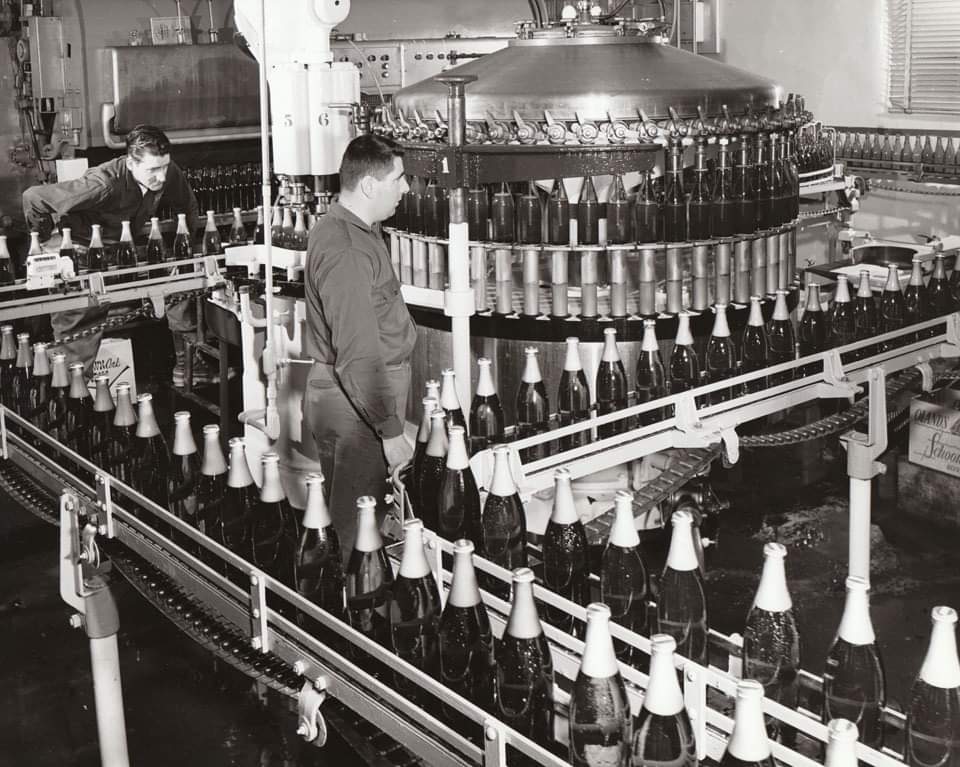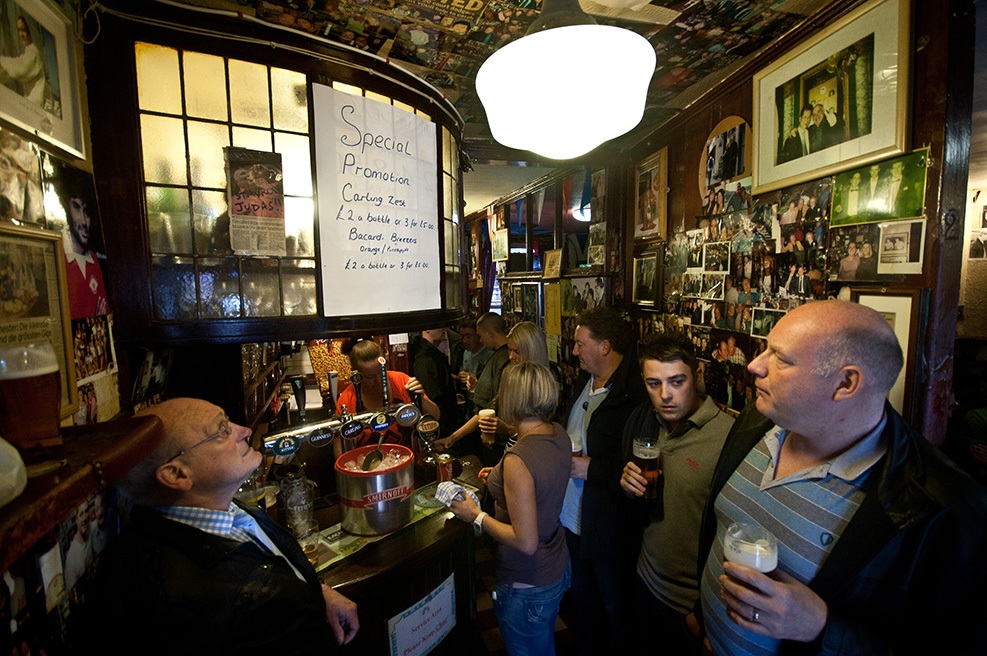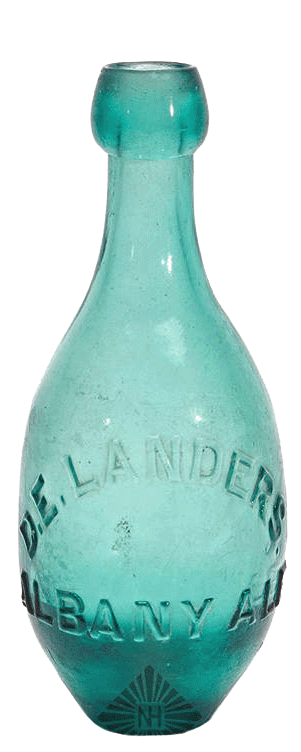 Tra-laa! How many first posts in May have I “tra-laa-ed” at you? It is because I have no imagination? NO! It’s because it’s from the musical Camelot which earned 110% of it’s reputation to Canada’s greatest gift to world culture, Mr. Robert Goulet!!! Surely the handsomest man of the 20th century. And a clinker of a drink or two, as illustrated. What’s that got to do with beer? WHHHAAAATTTT??? Have you lost your marbles? First, he had a TV show called Blue Light which is obviously the inspiration for Blue Light. AND he did TV ads for Molson Canadian which was owned then (and are again) by the owners of the Montreal Canadiens at the time. Who were right in the middle of proving themselves as the greatest hockey team of all time. Tra. La.
Tra-laa! How many first posts in May have I “tra-laa-ed” at you? It is because I have no imagination? NO! It’s because it’s from the musical Camelot which earned 110% of it’s reputation to Canada’s greatest gift to world culture, Mr. Robert Goulet!!! Surely the handsomest man of the 20th century. And a clinker of a drink or two, as illustrated. What’s that got to do with beer? WHHHAAAATTTT??? Have you lost your marbles? First, he had a TV show called Blue Light which is obviously the inspiration for Blue Light. AND he did TV ads for Molson Canadian which was owned then (and are again) by the owners of the Montreal Canadiens at the time. Who were right in the middle of proving themselves as the greatest hockey team of all time. Tra. La.
First up this week, happy news as those purveyors of interesting stories, Pellicle, hit its fourth anniversary which by my fingers and toes makes it 20% of this here AGBB‘s longevity. There is a party this very evening or, if you are western hemispheric, this afternoon. You know, at work there is a portrait (like these) of Michael Flannagan, our fair city’s municipal clerk who was in office from the 1840s to the 1890s. If I retire in five years as might be normal I will have made it to what I call the half-Flannagan. In 12 years, Pellicle will half-Flannagan me. Happy news.
And by way of proving the point of their prominence, Pellicle posted a piece (Ed.: STOP IT!!!) on The Five Points Brewing Company, Hackney Downs railway arch, London and its dedication to the craft of cask – with some particularly proper beer pR0n photography (Ed.: STOP!!!!):
“Cask beer is the very definition of craft beer,” Ed says. “Some people can think of cask beer as something different from craft… that it’s boring, brown, British bitter, and craft beer is all about New World hops, and intense flavour experiences, and carbonation. But craft beer is actually about provenance and quality and artisanal approaches to manufacturing,” he adds. “And it’s not just about the manufacturing process, it’s the dispense process. It’s a living, breathing product that continues to condition in the cellar, and that is an art form in itself.”
Me, I can get into that idea of “provenance” way ahead of claims to terrior.
In the police blotter update, I am not sure if this new federal amending statute applies to this here place and whether soon I can expect to be in handcuffs, taken away based in part by your petitions. I am probably sure it will go unnoticed by the law just as the rest of society ignores it… but it is interesting interesting to note that the summary of the amendments to be found at section 2(3) of Chap 8, First Session, Forty-fourth Parliament, 70-71 Elizabeth II – 1 Charles III, 2021-2022-2023 (aka Bill C-11):
…specify that the Act does not apply in respect of programs uploaded to an online undertaking that provides a social media service by a user of the service, unless the programs are prescribed by regulation…
Interesting that they use the phrase “social media service” which may or may not inclue WordPress. And what is a blog if not a soap opera which is indubitably a program. We await the regs.
Boak and Bailey wrote a lovely and well reasearched piece on the lost pubs of Bristol by way of a bit of a tour:
Next, let’s turn left onto Mary-le-Port Street. Except it’s not there any more, so we can’t, really, but we can cut through the park to look at the ruins of St Mary-le-Port Church hidden behind the brutalist Lloyds Bank and modernist Norwich Union building. Then follow the path that tracks the old street pattern towards the site of The Raven. C.F. Deming, author of Old Inns of Bristol, published in 1943, reckoned The Raven dated back to the 17th century and was “mentioned in 1643”.
The article immediately reminded me of the time, gosh, ten years ago when Craig and I went a wandering in Albany NY, looking for evidence of the 1600s town and found the King’s Arms tavern intersection where the American Revolution started locally and where, interestingly, my fair city of Kingston, Ontario was in a very real way born:
But that, oddly, is not my point in posting that picture. Do you see how the street distinctly turns to the left? That turn expresses something a hundred years older than the King’s Arms, the southern design of the palisades of the original settlement. You can see it in this map from 1770 but, more particularly, you can see it in the 1695 map Craig posted to describe the community in the 1600s Dutch era.
Three or four eras in one small corner of Albany: 2013 when the photo was taken, the late 1800s buildings, the revolutionary-era tavern intersectiton and the curve of the 1600 pallisades. Lesson: everybody take B+B’s advice, get outside and look around you! It’s remarkable to see what isn’t quite not there.
 Not for any particular reason other than it is a very nice portrait of some very nice beer people having a nice bit bit of beer. The source. The setting.
Not for any particular reason other than it is a very nice portrait of some very nice beer people having a nice bit bit of beer. The source. The setting.
Jordan by way of IG (the app which I personally hope Bill C-11 SHUTS DOWN) has declared a winner!
There have been lager brewers in Ontario. O’Keefe, Reinhardt, Carling, Labatt. I walk past Toronto’s first lager brewer, John Walz, several times a week in Mount Pleasant Cemetary. I spent so much time looking at fire insurance maps that I researched corrugated iton. I spent so much time reading documents that I needed a nap. I wrote histories. With the help of @wornoldhat, we reviewed all the beer in the province twice. I’ve seen the vast majority of the beer that exists in the modern era of brewing. I checked with people I respect about it, including @beaumontdrinks. I legitimately think that Godspeed’s Pitch Lined Sklepnik is the best lager style beer that had ever existed in Ontario. First to Last. It is SIX DOLLARS A PINT on Sundays.
I love the non-pitched home delivered Sklepnik so have no reason to disagree. And I would not limit that to Ontario. And… I bought a mixed case with some in it because I see that it’s in cans and available for delivery right now. Big sale on Tmavý Ležák 12º. Just saying…
Nineteen years ago, I included Black Sheep Ale in a list of well loved English pale ales that I could find in my eastern Ontario nothern NY ecosystem. Well, this week the brewery went into administration, a step short of bankruptcy:
The Black Sheep Brewery has announced that it intends to appoint administrators to protect the interests of its creditors after the business was hit by a “perfect storm” caused by the pandemic and rising costs. A spokesman for Black Sheep, which is based in Masham, North Yorkshire, stressed that the business is trading as normal and there have been no job losses to date. It employs around 50 staff.
Fingers crossed. Malt still being delivered. And remember you can see Black Sheep as it was in 1997 in this broadcast of the Two Fat Ladies, those foundational thinkers in relation to my life with food and drink.
Beth Demmons has another great edition of Prohibitchin’ out, this time on NA winery Null Wines‘ co-founders Catherine Diao and Dorothy Munholland in which a very good argument is made, one that might move a skeptic like me:
The vast majority of people buying non-alcoholic beverages also drink alcohol, suggesting that NA alternatives are simply an extension of choice rather than trying to act as strict replacements to their boozy counterparts. Dorothy and Catherine say giving consumers more high-quality options was the driving force of launching their business rather than chasing a trend. “One of our internal guideposts for ourselves is ‘Don’t add more crap to the world,’” says Catherine.
 Skeptic? Well, when the shadowy Portman Group is jumping on the bandwagon you have to wonder. By the way, look right. What a weird photo to illustrate NA bevvying in the news article. In any other context in any other decade, that image is pure code for being stoned out of one’s cranium. Very mixed message, PG. Very mixed indeed. Can’t be having that. You best be having a word with the Evening Standard.
Skeptic? Well, when the shadowy Portman Group is jumping on the bandwagon you have to wonder. By the way, look right. What a weird photo to illustrate NA bevvying in the news article. In any other context in any other decade, that image is pure code for being stoned out of one’s cranium. Very mixed message, PG. Very mixed indeed. Can’t be having that. You best be having a word with the Evening Standard.
Question: consider this from Mr.B:
I am repeatedly amazed by the speed with which respected and accomplished chefs will attach their names to suspect beers, ciders, coolers, and seltzers, while at the same time touting the quality of ingredients in their dishes. #MoneyTalks
Aside from the bald accusation of the role of money (something as common enough in beer), if no one has convinced most restaurants high and low from having a serious beer list, well, is this not something that advocates for treating beer more seriously have to take some responsibility for? Let’s be honest – if folks actually wanted it by now folk would have it by now.
Somewhat relatedly… seven years out forecasting. When everything matters does anything matter #3928? As scheduled:
WHY IT MATTERS: The growing strength of Modelo’s cheladas and aguas frescas point to a likely second act for a beer brand that, if current trends continue, is set to unseat Bud Light as the U.S.’s top-selling beer (by dollars) by 2030.
Less cheerily, at the end of last week just after hitting the publish button over here at AGBB HQ, Ruvani de Silva posted a very detailed, well researched and extended piece on the experience of being subject to online trolling as part of the bro culture side of craft beer world (which I have to admit for me isn’t limited to males as I have been on the receiving end from women, too.) But I immediately took to it as it made me think of the causes of craft’s bro culture.
Societal bigotry, yes, but also vestiges of X-Treme? Maybe tribal claims to one community, expertise with a leadership class fed by great white male hagiographies of semi-phony founders?.
I should have added booze obvs. But what do I mean by expertise? Perhaps this sort of smug self-affirmed but highly dubious expertise as opposed to this sort of largely self-driven expertise that makes no claims to extrapolation or even… you know… social status or higher moral ground*! David Jesudason’s thoughts were this:
Thoughtful piece. It mentions some abuse I got. I reported it but the police did nowt. Luckily I’ve done lots of work on resilience and it isn’t a trigger tbh. But some of the other types of trolling I do find difficult including subtweeting criticism cos I hate being ignored…
What else is going on? Not unrelatedly, this past Monday Stan commented on Jeff’s comments on Bud Lite’s maker’s woes following learning they were utterly unprepared and botched the response to their hiring of a trans woman Dylan Mulvaney for an ad campaign. The comment of Jeff’s that Stan considered began with this: “…years ago, I argued that it’s bad business for companies to take political positions. That was correct then, but it’s not anymore.” Note: Jeff made that earlier statement in October 2016 just before the US election when he wrote about Yuengling endorsing Donald Trump. He said it was a bad move. With total respect, I don’t really agree partially as democracy needs robust debate but also because I’m also not sure the two situations are even comparables as that would depend on the badness of the business move being the measure. Still, put it this way if I am wrong: at this point are we sure who is worse, the makers of Yuengling or Bud Lite?
Stan then broadened the question on how it reflects on the whole brewing trade and, again with total respect, drew in something which I have never actually found to be all that true:
Small breweries that some call “craft” have benefited by what is unspoken; that they are the good guys. Recently, they’ve been asked to prove it. Many have. The rest? We’ll see what happens.
The good guys? Really? How good is craft? Certainly doubts are raise by initiatives like the early and short lived co-opting of outrage against the war in Ukraine, the perhaps slightly deeper response with some to the Black is Beautiful initiatives even if not all the money ended up in the pockets pledged – not to mention, as Stan mentioned two weeks ago, the dimming of interest in DEI. (And not to mention… the continuation of bigoted operations like Founders… dots connected.)** Yup, it seems like its all just news cycle compassion so much of the time with craft.* Which builds on the question. Who is worse: the makers of Yuengling, the makers of Bud Lite or the appropriators of craft?
There’s another thing, a more important thing. I don’t believe that the existence of human rights even depends on political power or even the majority of folks’ conviction – and certainly not the stance of commercial operations like a brewery. Human rights are fundamental – a foundational fundamental good, not something politically sourced even if their denial by bastards in power is. Human rights speak to the simple inherent dignity of being a human in all its forms of subjective experience. The dignity shines through any denial and is always worth the fight. I hate to break it to you – but sooner or later we all will have one or more human characteristics which will annoy or even generate hatred by somebody. Don’t believe me? Wait for age. No, we can’t cherry pick which human rights are the winners. It’s all or none. Bandwaggoning the news cycle like craft isn’t any sort of conviction in support of human rights any more than leaving it to any stripe of politicans is. These are really appropriations of goodness. So show me a brewery that welcomes all, that straight up supports human dignity with action and little fanfare and I am there.*** Are there are all that many? Dunno but I do spend my money where there is a chance that they just might be worth my support. I suggest you do the same. It can have an effect. And if these my previous few hundreds of perhaps wandering words don’t convince you, think of what Brian Alberts wrote with just a handful:
Don’t just stick to beer, stick to just beer.****
Why? It matters. This actually matters.
That’s enough from me. You want more? As per, you can check out the many ways to connect including these voices on Mastodon:
Stan Hieronymus | The Man!
Boak & Bailey | The B² experience
Katie Mather | Shiny Biscuit and Corto
David Jesudason | “Desi Pubs” (2023) author
Ron Pattinson | The RonAlongAThon Himself
Al Reece AKA Velky Al | Fuggled
Jennifer Jordan | US hops historian
Alan McLeod | A Good Beer Blog (… me…)
Andreas Krennmair | Vienna beer and lager historian
Beer Ladies Podcast | Lisa Grimm and colleagues
Jay Brooks | Brookston Beer Bulletin
Joe Stange | Belgian beer expert, beer magazine editor
Cider Bar | Barry makes Kertelreiter cider
Laura Hadland | CAMRA historian and beer writer
Brian Alberts | US beer historian
Jon Abernathy | The Beer Site
Maureen Ogle | US Beer Historian
Lars Garshol | Norwegian Beer Historian and Kveik Hunter
James Beeson | Beeson on Beer
Carla Jean | MAINER!!!
Thandi Guilherme | Beer Ladies Podcast Co-host
Lisa Grimm | Beer Ladies Podcast Co-host
Rob Talksbeer | Podcaster and Youtuber
Anthony Gladman | UK Drinks Writer
Jeff Alworth | Manna Of Beervana
Northwest Beer Guide | Fairly self explanatory… but not NW Latvia…
Evan Rail | Prague based GBH editor, freelance writer, NYT etc.
Todd Alström | 50% of the Alströms
Jacob Berg | Beer talking librarian
Anyone else? And, yes, we also check the blogs, podcasts and newsletters to stay on top of things – including more weekly recommendations from Boak and Bailey every Saturday and Stan at his spot on those Mondays! Get your emailed issue of Episodes of my Pub Life by David Jesudason on many Fridays. Once a month, Will Hawkes issues his London Beer City newsletter and do sign up for Katie’s now more occassional but always wonderful newsletter, The Gulp, too. Ben’s Beer and Badword is back! And check out the Atlantic Canada Beer Blog‘s weekly roundup. There is new reading at The Glass. Any more? Yes! Check to see the highly recommended Beer Ladies Podcast. And the long standing Beervana podcast . There is the Boys Are From Märzen podcast too and check out the travel vids at Ontario’s own A Quick Beer. There is more from DaftAboutCraft‘s podcast, too. All About Beer has introduced a podcast. There’s also The Perfect Pour. Plus follow the venerable Full Pint podcast. And the Craft Beer Channel this week on Youtube. And remember BeerEdge, too, and The Moon Under Water… if you have $10 a month for this sort of thing… I don’t. Pete Brown’s costs a fifth of that. There was also the Beer O’clock Show but that was gone after a ten year run but returned renewed and here is the link!*****
*Yes, a double footnote… but why always place craft beer on the rosy glowing end of the good-bad spectrum with, you know, Donald Trump at the other Satanic end. Isn’t this obviously self-serving, all this praise from within craft beer for craft beer? (Looka me! I’m part of a community!! ) And another thing… what the heck has craft beer ever actually done to stake its claim to a higher moral position? Do you think of your favorite shoe stores that way, your coffee shops, your cheddar and gin makers or neighbourhood bakers? Actually, I do know bakers who ensure their surplus gets to the homeless day after day so, yes, props to those bakers.
**Can you believe this shit: “When Dillard reported the incidents to management, she alleges that she received drastically reduced hours as retaliation or was ignored. The complaint also states she worked as a part-time manager for nearly a year without moving up, while white managers were promoted within months. The complaint also details alleged instances of sexual harassment from a fellow worker. When Dillard complained about the behavior, she says she was ignored. But once a white employee complained about the same behavior from the same worker, the offending worker was fired. Things were so bad that a white manager also resigned because of the ongoing racial discrimination against Dillard.” H/T to The Polk.
***Could you get a wheelchair in the taproom bathroom? Does the sort of language used on the brewing floor align with the branding?
****Cleverly succinct. Reminds me of a Billy Bragg quip from a concert maybe 35 years ago: “Remember: it’s not ‘how high are you?’ – it’s ‘hi how are you?'”
*****And finally the list of the departed newsletters and podcasts or those in purgatory. Looks like both Brewsround and Cabin Fever died in 2020, . We appreciate that the OCBG Podcast is on a very quiet schedule these days – but it’s been there now and again. The Fizz died in 2019. Plus Fermentation Radio with Emma Inch seems done and the AfroBeerChick podcast is gone as well! The Fingers Podcast packed it in citing, umm, lack of success… as might have been anticipated, honestly. Did they suffer a common fate? Who knows?
















